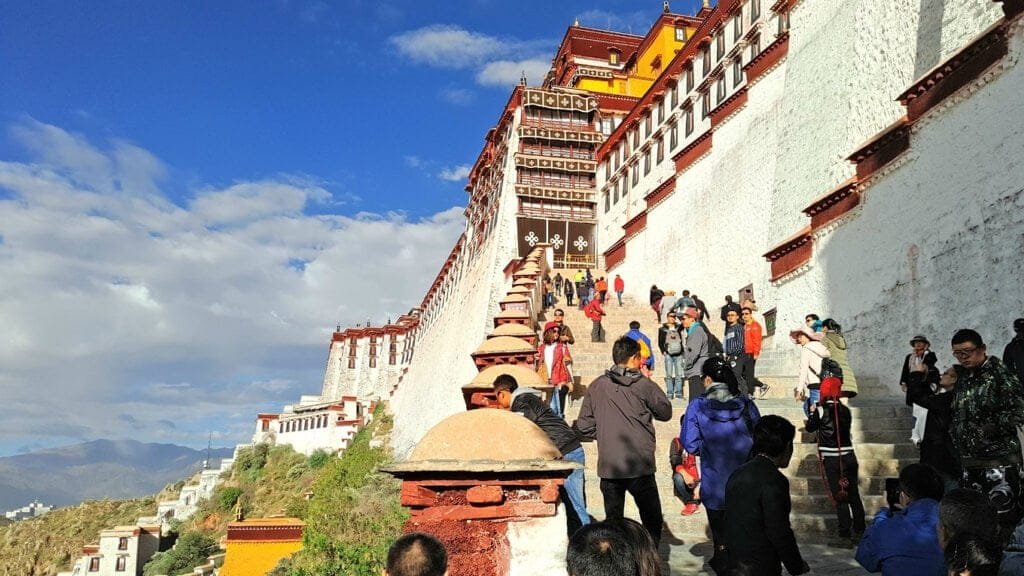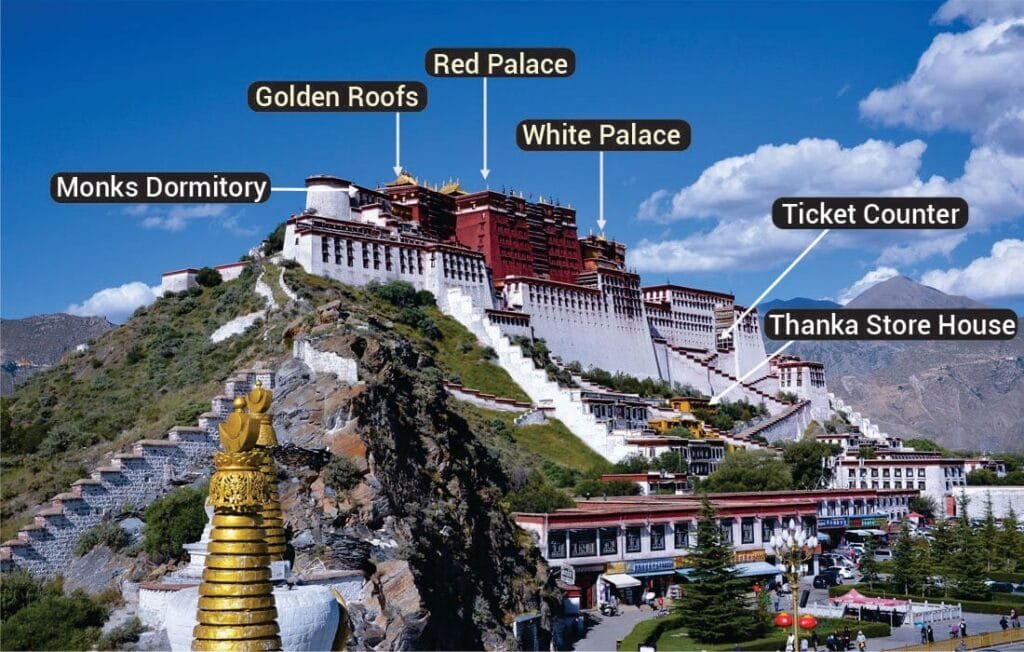The Potala Palace is a remarkable example of Tibetan architectural mastery, especially when it comes to its proportions and scale. These elements serve not only functional and aesthetic purposes but also imbue the structure with profound symbolism and emotional resonance.
Potala Palace Architecture: Proportions, Scale, and Grandeur
The Potala Palace, an iconic symbol of Tibetan architecture, is renowned for its precise proportions and grand scale. Its structural elements follow a consistent modular system, ensuring balance and harmony throughout the palace.
Proportions and Structural Harmony
One of the defining features of Potala Palace architecture is the uniformity of its structural elements. Columns and beams are typically around 2.2 meters in length, creating a repeating spatial module that enhances the palace’s structural integrity and aesthetic appeal.
Square Modular Design
The palace incorporates a square or nearly square module system, which contributes to its symmetrical and cohesive layout. This design approach ensures both functionality and visual harmony, making the palace a masterpiece of Tibetan architecture.
Massive Walls vs. Narrow Windows
A key characteristic of Tibetan fortress-style architecture is the contrast between its thick, imposing walls and tall, narrow windows. This interplay not only reinforces the defensive nature of the palace but also highlights its spiritual significance. The massive walls create a sense of security, while the elevated windows allow light to filter into sacred spaces, adding to the mystical ambiance.
Scale and Grandeur of the Potala Palace
The monumental scale of the Potala Palace enhances its majestic presence, making it one of the most awe-inspiring architectural wonders in the world.
Visual Dominance and Grand Design
- The fortress-like walls and expansive staircases amplify the palace’s monumental grandeur.
- Even the smallest decorative elements, such as gilded roof ornaments and prayer flags, are designed to be visible from great distances. This ensures that the immensity and sacredness of the palace can be appreciated from multiple vantage points.
The Potala Palace’s architectural proportions and grand scale make it an enduring marvel of Tibetan culture, history, and spirituality. Its unique blend of symmetry, massiveness, and intricate details continues to captivate visitors and researchers alike.

Viewing Angles and Spatial Relationships
The Potala Palace is crafted to command attention from all angles, a feat that requires careful consideration of its spatial relationships and viewing angles.
- Perfect Vantage Point: Located about 100 meters south of the palace, an inscription stone creates an ideal viewing spot. From here, the vertical viewing angle offers the most comprehensive perspective of the palace’s verticality and grandeur. The horizontal viewing angles, too, are carefully calculated to provide the best immersive experience.
- Designed Immersion: The layout and design of the palace ensure that visitors experience a gradual immersion into the architectural wonder, with every space, corridor, and plaza contributing to the overall sense of awe and reverence.
The Potala Palace’s design embodies a sophisticated understanding of emotional resonance, ensuring that each element serves not only a practical purpose but also a spiritual and aesthetic one, enhancing the sense of connection with the Tibetan cultural and religious identity.
Unique Architectural Details of the Potala Palace
The Potala Palace is full of distinctive features, from its eaves to its color scheme, that highlight the cultural, climatic, and spiritual principles of Tibetan architecture.
Eaves, Windows, Doors, and Color Scheme:
- Eaves: The palace features distinct eaves made with bemar walls, decorated with intricate motifs such as copper gilt Sanskrit patterns, Dharmachakra (Wheel of Dharma), animals like rhinos and Garudas, and auspicious symbols like the Ashtamangala (Eight Auspicious Symbols). These elements symbolize the radiance of the sun, moon, and stars, radiating from Mount Meru, a central cosmic axis in Tibetan Buddhism.
- Windows and Doors: The windows and doors follow traditional Tibetan design, with narrow windows for insulation in the colder climates of Lhasa. However, in more significant areas, larger windows and floor-to-ceiling doors are used, along with balconies and railings for added functionality and aesthetic grandeur.
- Color Scheme: The Potala Palace’s color palette is striking and symbolic:
- White walls represent peace and tranquility.
- The Red Palace is painted in deep ochre, signifying dignity and solemnity.
- Chrome yellow accents signify prosperity and spiritual richness.
- The golden roofs shimmer in the sunlight, symbolizing divine radiance.
These colors are not only aesthetically pleasing but also reinforce the spiritual and symbolic themes central to the palace’s role as a center of Tibetan power and religion.
Foundation, Walls, and Wooden Framework of the Potala Palace
The Potala Palace, a UNESCO World Heritage site, stands as a testament to Tibetan architectural brilliance. Built with exceptional engineering techniques, its foundation, walls, and wooden framework contribute to its resilience and grandeur.
Foundation: Stability on Varied Terrain
The foundation of the Potala Palace varies based on the terrain to ensure maximum stability.
- Lhasa’s Frost Layer Considerations: In Lhasa, where the frost layer can reach 0.7 meters deep, the foundation is built 0.5 to 0.8 meters deep, using compacted earth and stones for reinforcement.
- Mountainous Terrain Adaptation: On mountain slopes, the palace’s foundation is directly built upon rock, providing additional stability and durability against natural forces.
Walls: Strength and Aesthetic Significance
The walls of the Potala Palace are meticulously constructed using stone, rammed earth, and mud bricks, ensuring both structural integrity and aesthetic appeal.
- Stone Masonry: The thick stone walls feature tightly interlocking stones bonded with mud mortar, enhancing durability.
- Symbolic Wall Decorations: Some walls are adorned with sacred symbols and ornate designs, reflecting the spiritual significance of the palace and adding to its visual grandeur.
Traditional Wooden Framework: Tibetan Carpentry Excellence
The wooden framework of the Potala Palace exemplifies traditional Tibetan carpentry, characterized by metal-free joinery techniques.
Timber Sourcing & Construction
- Due to limited timber availability in Lhasa, wood was sourced from distant regions, leading to the use of shorter timber lengths for easier transportation.
- Structural elements such as columns, beams, capitals, and rafters are seamlessly joined without metal fasteners, showcasing advanced woodworking techniques.
Gilded Decorations: Symbolism & Grandeur
- Columns and beams are adorned with gilt copper bands and mythical creatures, enhancing the palace’s spiritual and artistic significance.
- These intricate decorations symbolize divine protection and reinforce the palace’s sacred status in Tibetan Buddhism.
The Potala Palace’s foundation, walls, and wooden framework are prime examples of Tibetan engineering and artistic craftsmanship. Built to withstand the elements while preserving its spiritual and historical legacy, the palace continues to captivate visitors with its architectural mastery and sacred aura.

The Potala Palace stands as a timeless masterpiece of Tibetan architecture. From its harmonious proportions and grand scale to its intricate architectural details and profound symbolism, the palace is an extraordinary fusion of spiritual, cultural, and functional design. Every element of the palace, from its eaves to its color palette, speaks to the ingenuity and spiritual vision of its creators, making the Potala Palace not only an architectural wonder but also a deep reflection of Tibetan identity and its rich heritage.
The Potala Palace: A Masterpiece of Tibetan Architecture
The Potala Palace stands as an iconic symbol of Tibetan culture, blending architectural brilliance with profound spiritual significance. From its bemar walls to its golden roofs, each element of the palace is rich with history and meaning, embodying the political and religious center of Tibetan Buddhism.
Bemar Walls: Symbolism and Design
The term “Bemar” refers to willow in Tibetan, but in architecture, it denotes the distinctive ochre-red walls that are a hallmark of Tibetan architecture. The bemar walls are particularly symbolic and are used in structures associated with high-ranking Lamas, such as the Dalai Lama, Panchen Lama, and temples housing important Buddhist scriptures like the Kangyur and Tengyur.
- Symbol of Nobility: The bemar walls, adorned with protruding beams and rafters, enhance the decorative quality of the structure. These walls are especially prominent in the Potala Palace, where they symbolize Tibetan authority and religious power.
- Unique Design: The use of stacked stone plates and gilded metal components around the eaves is a rare feature in Tibetan architecture, contributing to the palace’s grandiose aesthetic.
Golden Roofs: A Mark of Prestige
The golden roofs atop important halls and temples serve as a symbol of spiritual and political significance. These roofs are made of gilded copper tiles and often have a hip-and-gable design, which is common in Tibetan architecture but not in traditional Han styles.
- The Red Palace: The Red Palace houses the stupas (or tashis) of several Dalai Lamas, including the Fifth, Seventh, Eighth, Ninth, and Thirteenth. The golden roofs here signify the importance and sacredness of the structures they cover.
- Gilding Techniques: The Fifth Dalai Lama’s era marked a significant advancement in Tibet’s gilding techniques, with the introduction of golden roofs as a symbol of the growing political and spiritual authority of the Dalai Lamas.
The Potala Palace: A Historic Symbol of Tibetan Governance
Built initially in the 7th century by Songtsen Gampo, the Potala Palace was envisioned as a fortress and a symbol of Tibetan strength. Although the original structure suffered damage from fires and political upheaval, the current Potala Palace, rebuilt in the 17th century, became the political and spiritual center of Tibet under the Gelugpa leadership of the Fifth Dalai Lama.
- Construction and Layout: The Potala Palace is built on Marpo Ri hill, featuring thirteen stories that reach a height of 115.4 meters. The palace walls are constructed from granite, with foundations embedded deeply in the rock to ensure stability against earthquakes. Its complex design includes a mix of temples, stupas, living quarters, and administrative offices.
- Color and Visual Appeal: The white and ochre red exterior contrasts sharply with the golden roofs, making the palace a visually striking landmark. This combination of colors enhances the grandeur and majesty of the structure, signaling its importance from afar.

Divisions and Functions of the Potala Palace
The Potala Palace is divided into two main sections: the White Palace (Potrang Karpo) and the Red Palace (Potrang Marpo), each with distinct functions related to the Dalai Lama’s residence and Tibetan governance.
The White Palace (Potrang Karpo)
The White Palace is the political and residential hub of the Dalai Lama. This section includes the Great East Hall, or Tsochin Dzam, which serves as the venue for significant religious and political ceremonies.
- The Dalai Lama’s Throne: The throne is placed in the north of the hall, and it is adorned with a red seal reading “Imperial Pen of Tongzhi,” signifying the Dalai Lama’s authority.
- East and West Sunlight Halls: These halls, bathed in sunlight, serve as living quarters for the Dalai Lama. The West Sunlight Hall housed the Thirteenth Dalai Lama, while the East Sunlight Hall is where the Fourteenth Dalai Lama resided. Both are known for their luxurious furnishings and precious stones.
The Red Palace (Potrang Marpo)
The Red Palace houses the stupas of the Dalai Lamas and is dedicated to religious functions. Here, the stupa hall of the Fifth Dalai Lama is a notable feature, as it also contains the stupas of the First, Second, and Tenth Dalai Lamas.
- Historical Artifacts: The palace is home to numerous historical artifacts, including thangkas, gold and jade seals, and Ming and Qing dynasty brocades. These items reflect the political and spiritual history of Tibet.
- Renovation and UNESCO Status: The Potala Palace underwent extensive renovation between 1989 and 1994, funded by the state to restore its grandeur. In 1994, it was inscribed on the UNESCO World Heritage List as a key cultural heritage site.
A Symbol of Tibetan Identity and Power
The Potala Palace is more than just an architectural marvel; it is a symbol of Tibet’s spiritual, cultural, and political legacy. With its bemar walls, golden roofs, and grandiose structure, the Potala Palace embodies the heart of Tibetan theocracy and the enduring strength of Tibetan culture. Its intricate design and historical significance make it a timeless icon, preserving the legacy of Tibet’s rulers and its rich religious traditions.
